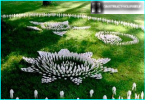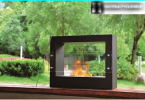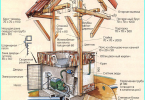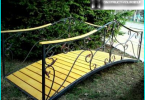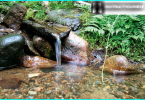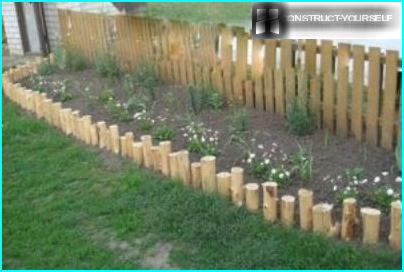
Elegant flower compositions – decoration of any plot. Colorful flower beds, the amazing variety of colors and shapes of flowers, leaves no one indifferent. But the highlight of the flower garden amid the lush vegetation of the site and highlight its beauty impossible without a decent frame. Decorative planter for the garden with their hands can not only transform the area, but also give your flower beds a finished appearance.
The contents
The types of pots and their functions
The distinctive feature of pots from traditional pot for plants is the lack of tank bottom drainage holes necessary to drain excess water. Besides the decorative function, a properly chosen capacity can facilitate the care of green pet.
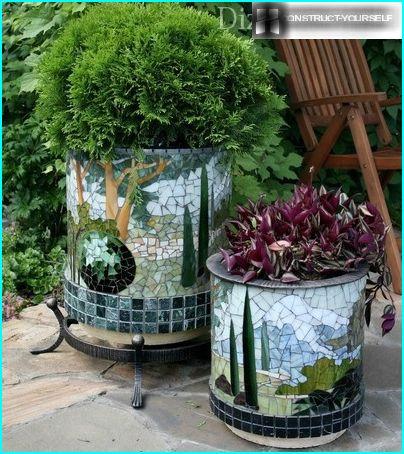
Since the main purpose of a decorative planter for the garden is to decorate the interior, the exterior surface of the containers in most cases make more beautiful and attractive
Depending on the material of manufacture planters for garden are of the following types:
- Plastic. One of the cheapest variants of the planter, whose main advantage is the light weight and ease of care.
- Wooden. Natural base containers helps to protect plant roots from cold and drying out, as well as to maintain optimal conditions for growth.
- Metal. Modern material, characterized by durability, perfect for outdoor landscaping.
- Clay. Material having a rough or smooth surface – a universal basis for the tie-dyes and jewelry modeling. But the ability to absorb moisture limit its scope.
- Ceramic. Natural material processed with special coating, widely used in interior decoration and garden design.
The main requirements that apply to pots for garden decoration – the ability to save the form given by the wizard, and high resistance to high soil moisture and temperature extremes.
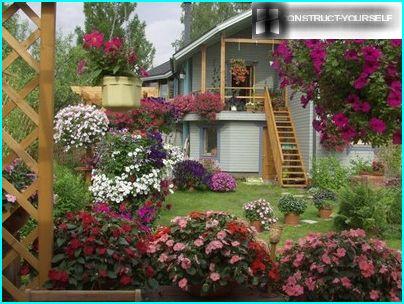
If we take the basis of the location of a makeshift flower bed, then there are outdoor construction and hanging pots for garden
Unusual use of old things
Street planters can be made from almost anything. In thing could go old stuff, carefully stored «just in case», furniture, dishes…
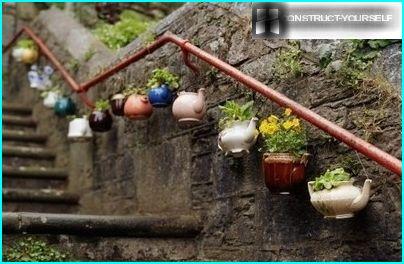
Unusual hanging planter can be made from old teapots, which you can place along the stairs, hanging on the wire
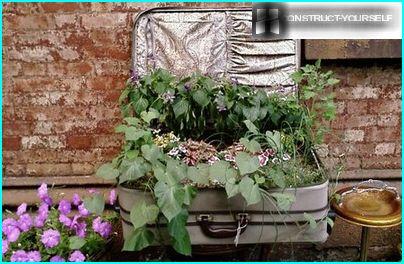
In the hands of a creative master second life can be even an old suitcase without a handle, which, as the saying goes — and hard to bear, but also throw a pity
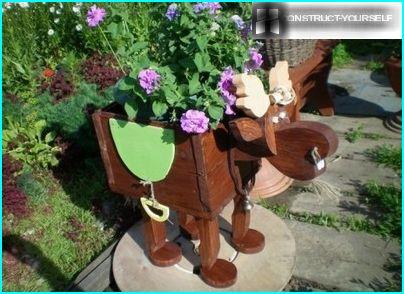
Wooden box, opened the stain and decorated in a cute fairy-tale calf, will be worthy of framing for the flower garden
Fill the suitcase easily, setting right a few pots with plants. If the height of the containers is significantly below the walls of the suitcase at the bottom of the pots, you can pour sea pebbles and stones, and the space between the containers to fill with moss or shredded bark.
The options for self-production pots
To make the original containers, able to blend in the landscape design and to act as its spectacular decoration, you can use the most diverse material: burlap and rope, the remains of the plastic film and plastic bottle, plaster and polymer clay… Any of these materials in the hands of a specialist can turn into an outstanding element of garden decor.
Decorative vase made from plaster
To make the original pots, which will serve not one year, you need to prepare:
- asbestos or polymer plaster;
- flexible wire for decorating the frame;
- construction bandages or strips of fabric with a width of 10 cm;
- ink and color on water-based;
- acrylic lacquer for exterior use.
Planters can be any shape: it depends on the basis for the frame. In our case, as an interim basis will be the plastic bucket 10 litres, which upon completion, will be retrieved.
A bucket mounted on a flat surface, turning upside down. To make the frame of the surface of the bucket odletem wire edge which is neatly folded and hidden. The resulting frame is removed from the bucket. Now you can start the breeding of plaster, the consistency of the finished form should resemble thick cream. In a container of plaster of Paris drop cloth strips or bandages, soaking them for 2-3 minutes. Our task is to impose a wire frame for the outer and inner walls. Strips of fabric, well soaked in a solution, layer-by-layer spread on to the frame until the wall thickness reaches 1.5-2 cm Remaining solution thoroughly coat the walls of pots. Design leave to dry for 12 hours.
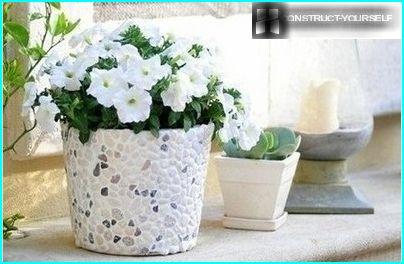
After complete solidification of the basics you can start making pots, decorating it with all sorts of pebbles, colored glass and beads
To do this, first flatten the surface, Stripping it with sandpaper. Then cover the bottom and sides of the product white latex paint on top of which a second layer is applied the desired background for applique or ornament.
Hanging pots from tires
Old car tyre is an excellent material for making decorative elements. Rubber has resistance to external impact and adverse weather conditions, owing to which he can regularly last for more than one season.
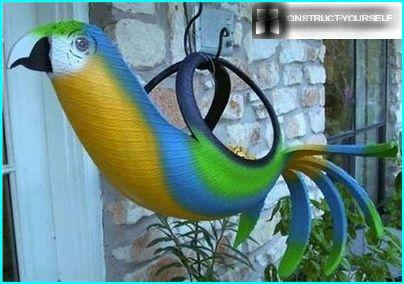
It’s hard to believe such a colorful parrot, it is important swaying under the canopy of a house or between branches of trees can be done in just one day with their hands
For the manufacture of hanging pots will need:
- the tyre without steel cord;
- a drill and a drill bit with a diameter of 10;
- sharp knife;
- washer M8 bolts and nuts;
- paints for external works.
To facilitate the work when cutting out the parts, the knife blade can be periodically moistened in liquid soap or detergent.
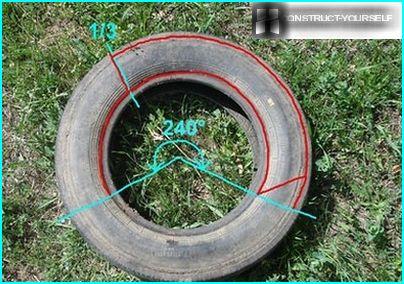
Along the side of the wheel on both sides of the tyre perform a symmetrical cut of 2/3. In the larger side notched tires through triangular cutouts detachable side
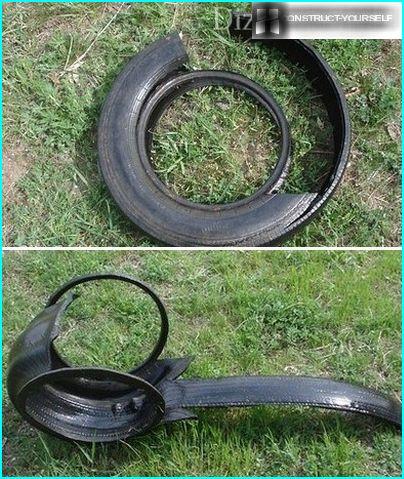
The result is a billet that is subsequently gently wrenched inside-out, giving the desired shape
The body of the parrot is ready: it remains to draw the head of the bird and to give it recognizable shape. For this purpose from scrap tyres cut out the beak.
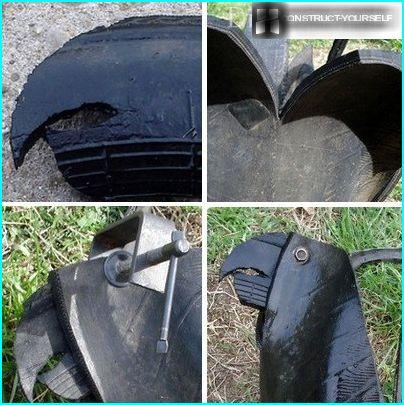
Cut the parrot’s beak is inserted into a longitudinal incision made with a sharp knife along the edge of the lower side of the body
Below the beak securely lock both halves of the compressible using strubiny, drilled through them, a through hole, through which then contracted with the bolt. To adjust the shape of birds already in place, perform a few cuts with a knife.
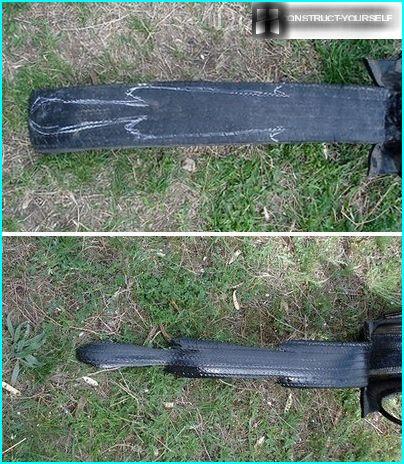
Of the long side of the workpiece at a pre-scheduled chalk the contour of the cut tail of an exotic bird
Parrot is ready: I have to pull the side of the unit with a rope or wire and then paint it in bright colors.
Outdoor vase of twigs
It will take the branches with a thickness of 0.7-1.5 cm, and thin cord or twine. If possible, it is better to give preference to the branches of a birch, viburnum and bamboo – they look the most interesting. Sticks better to choose the same thickness.
For the manufacture of pots, branches with a knife or secateurs cut about the same length, which should be 1-2 cm above the pot. Sticks-blank put close to each other on a flat surface and obitaem the string so to get the Mat, the length of which should be enough to wrap around the pot.
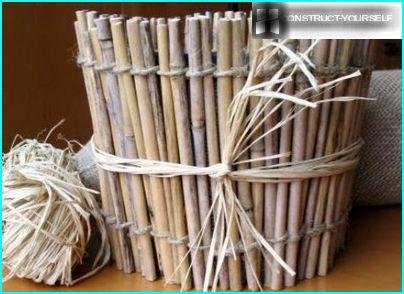
Thin tree branches left after pruning garden can be used as decorative elements. They can serve as a basis for making a beautiful planter that is perfect for the decoration of both the site itself and the interior of the house
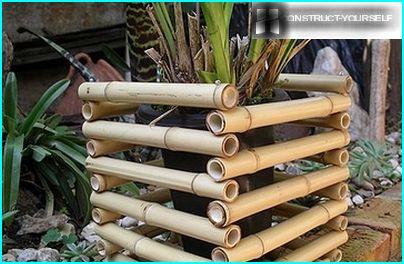
To create designs larger sizes it is better to use bamboo or bars of round or square cross-section, gathered in the form of a cube
Convenient option, when the twigs are glued on the basis of-burlap. Woven Mat wrap the outer wall of the pot and fasten the decoration with mottled satin ribbons or twine.

